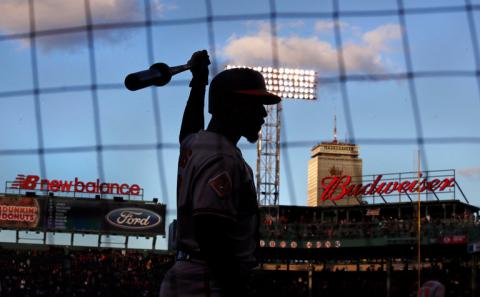Red Sox, Racism and Adam Jones
New York Times
May 5, 2017
by Doug Glanville
When I heard that the Baltimore Orioles outfielder Adam Jones was showered with racial epithets by fans at Fenway Park on Monday, it was easy for me to roll my eyes and say, “Of course — Boston.”
I’d carried Boston baggage since I was a teenager, so even after seven years of covering baseball for ESPN and doing many games at Fenway Park, where fans treated me wonderfully, it was still too easy to react that way. Jones’s experience made me try to understand why.
Back in 1997, before I was traded away by the Chicago Cubs, there was speculation as to where I would end up, and the two teams that always seemed to be in the conversation were the Philadelphia Phillies and the Boston Red Sox.
I did not want to go to Boston because of the aforementioned baggage.
The first time I recall being called the “N-word” by someone who understood the damage he was trying to inflict was when I was in elementary school. Imagine a kid, barely 10, walking home with an oversize book bag and passing a house with a guy sitting on the porch. The man not only hurls the N-word at me with pizazz, he opens up a switchblade and threatens me. I sped up my pace, and filed the incident away. Looking back, I was lucky.
Still, my hometown, Teaneck, N.J., was a beacon of diversity, and a pioneer in racial integration by voluntarily desegregating in the early 1960s. (Key word, “voluntarily.”) But my parents gave my brother and me doses of reality to temper the naïve lens through which we looked at the sport we loved, baseball.
We learned about Roberto Clemente and Jackie Robinson, but not just about the superhero side of their stories: the stress, the hate, the determination, the sense of purpose, the complete picture. I learned that the Red Sox were the last team to integrate, and I filed that away, too. Then there were the piecemeal anecdotes I was told about the Hall of Fame outfielder Jim Rice’s second-class citizenship at Red Sox spring training, stories about country clubs where Rice and other African-Americans were not welcome.
So even as a kid, I learned to be afraid of Boston and the Red Sox, and when I thought I would be traded to them, I was worried. At the time, I had very little evidence to counter my feelings.
As it happened, I went to Philadelphia, not Boston. In recent years I’ve run into the Red Sox general manager of that era, Dan Duquette (ironically, now the G.M. of the Orioles — Adam Jones’s team), and he mentioned how close he’d been to trading for me in 1997. But I never told him of my concern at the time. If I had been traded to Boston, would I have tried to veto it like Curt Flood, who rejected his trade to Philadelphia and refused to go? I wondered if I understood that it would have ended my career before it started, without even giving the city and the team a chance.
The city’s reputation certainly was something I thought about in 1999 when I was on the Phillies and in Boston for a series. On three successive days my brother and I went out to eat — or tried to. At each place the host or hostess treated us rudely, if bothering to greet us at all. I could not recall having had that kind of dining experience in-season anywhere else at that point in my major league career. Is it possible I happened to pick three restaurants in a row where the staff was just having a bad day? Maybe.
In the end, it is not about just Adam Jones, or Boston, or overt racism, or “a few bad apples.” There are larger implications and even better lessons. Many people in our country experience a version of racial animosity, sometimes routinely. It is important to recognize that a vast majority of Boston fans categorically rejected that kind of racist rhetoric. My great Fenway experiences as a player and as an announcer are part of the evidence, too.
But we need to absorb the idea that racism can work covertly and thrive in smaller moments that go under the radar, but that we still must educate ourselves about: redlining, rejection by a taxi driver, biased school enrollment policy, profiling. All of which have happened to me frequently, by the way. These are not rare occurrences like the public way Jones was abused in a major League park, but private slights that are part of daily life for many minorities. They can happen anywhere, anytime. Boston does not deserve the brunt of the criticism.
We also have to be careful about reducing every situation to “a few bad apples.” When that 1 percent happens, it feels like 100 percent to you. So the fact that I never heard anyone yell the N-word at me during my major league career doesn’t mean I won the lottery, because I still experienced racism trying to buy a home, finding a school for my kids or just walking down the street of an affluent neighborhood.
I tweeted thanks to the Red Sox fans for the standing ovation given to Jones. For me, it was powerfully restorative. I felt like the fans were somehow recognizing my struggles with racism, too — mine and every other person who knows the pain of being negatively singled out for one’s heritage or color. And we have to recognize that the Red Sox’s aggressive response against it probably would have gone differently if it had been the Red Sox of my teenage years. That is progress.
We all can learn that just as it is unfair to categorically label an entire city or fan base in one stroke, it is equally unfair to categorize a group of people because someone broke into your car, or blame an entire ethnic group because some kids who got bused into your school system are assumed to have lowered your test scores.
Baseball gives us a chance to see ourselves in everyone, at times reflecting the image of some complex and difficult shadows in our society. That is a big step toward mutual understanding. As hard as it is, we need to see ourselves in the fans who were ejected. Having biases is human, our flawed yet efficient way to create shortcuts in our lives. But we need to check them more honestly if we are to really understand how to move forward.
Republished from The New York Times
Photo: Baltimore Orioles’ Adam Jones prepares to bat before the first inning against the Boston Red Sox at Fenway Park in Boston on Wednesday.
Photo Credit: Charles Krupa/Associated Press






